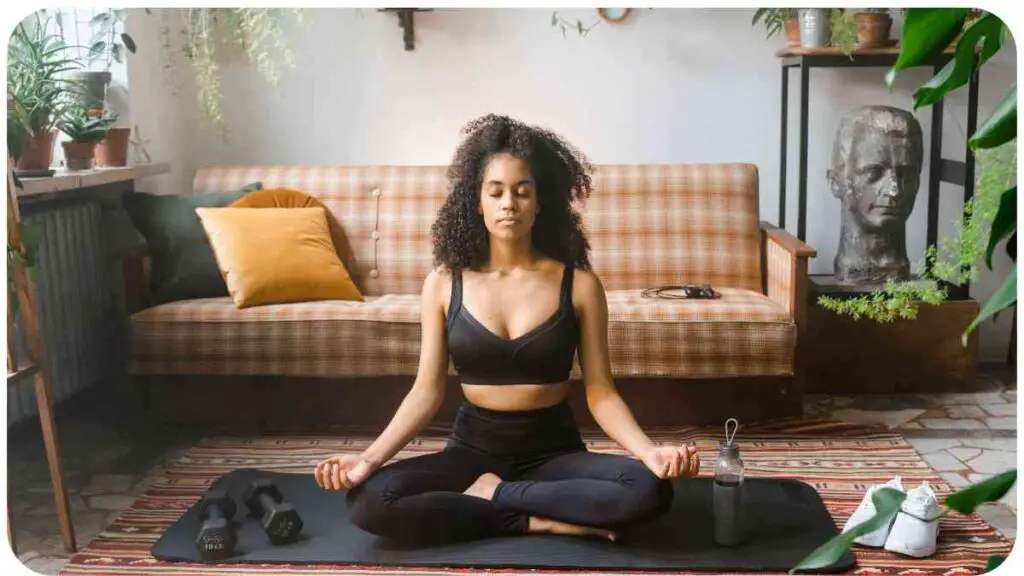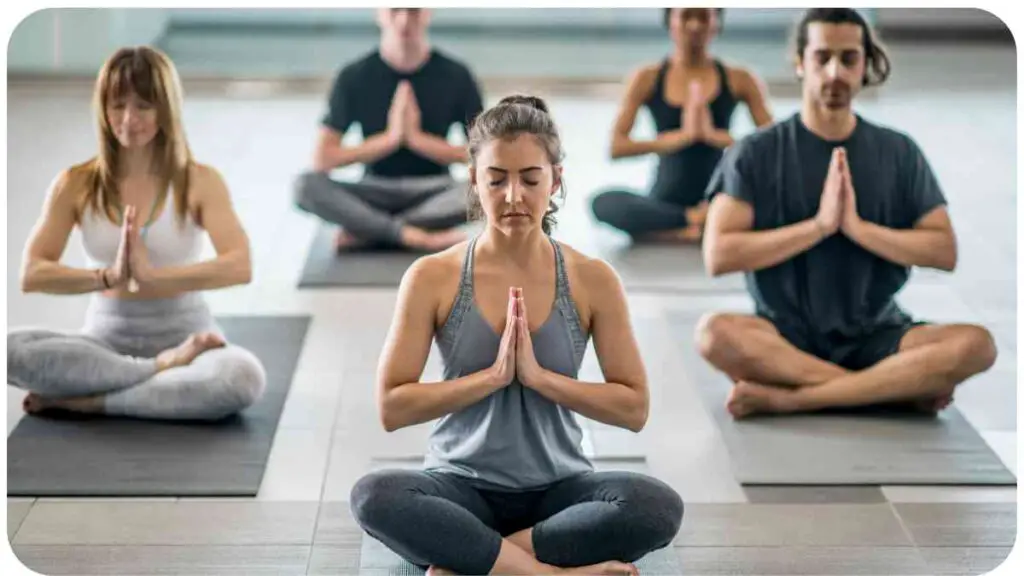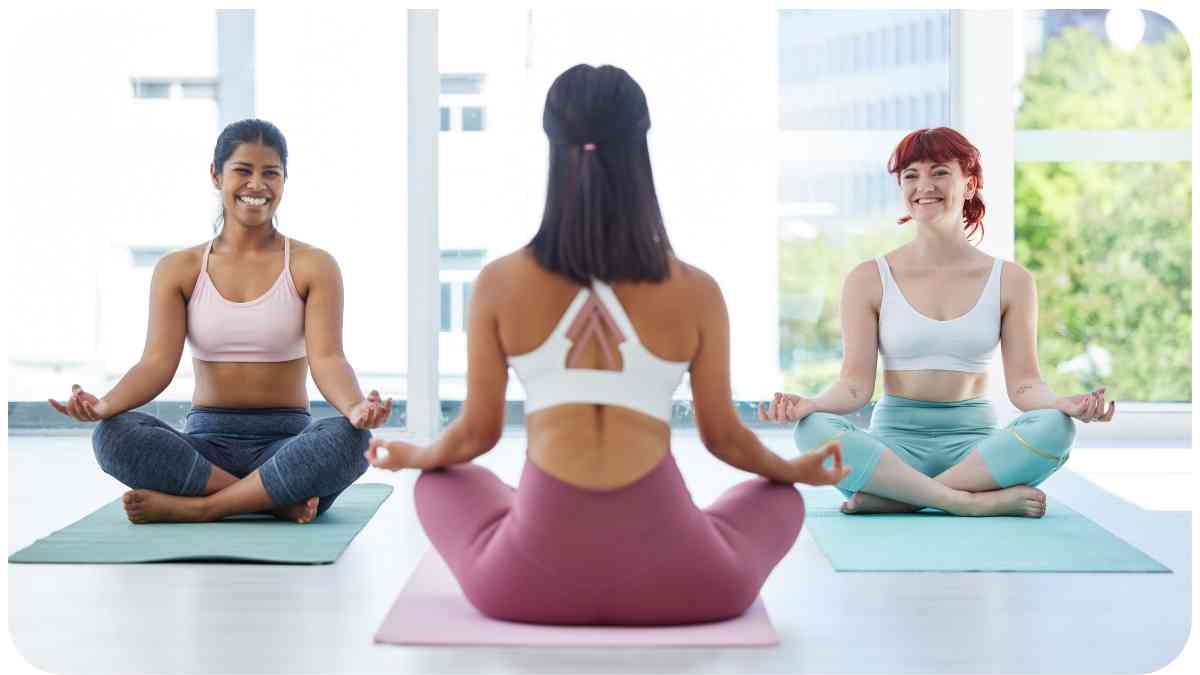Yoga has long been praised for its ability to relax the mind and body, but what happens when your yoga practice isn’t delivering the expected relaxation? Many practitioners find themselves in this situation, feeling frustrated and unsure of how to proceed.
In this article, we’ll explore common reasons why yoga may not feel relaxing and provide actionable tips to help you reclaim the tranquility you seek.
| Takeaways |
|---|
| 1. Explore insights on relaxation through yoga and mindfulness practices. |
| 2. Discover reasons why yoga may not work for everyone and alternative stress relief methods. |
| 3. Learn about yoga’s benefits for stress management and overall well-being in teens. |
| 4. Practice mindfulness and compassion to prevent yoga from feeling stressful. |
| 5. Incorporate gentle movements, deep breathing, and meditation to enhance relaxation in yoga practice. |
| 6. Experiment with different yoga poses to find those that promote relaxation for you. |
| 7. Start with shorter meditation sessions and gradually increase duration. |
| 8. Consider seeking professional guidance for personalized support and strategies if yoga isn’t relaxing for you. |
2. Understanding the Disconnect
Yoga is meant to be a calming and rejuvenating practice, but several factors can contribute to it feeling anything but relaxing. Let’s delve into some of these reasons:
Athletes can greatly benefit from incorporating yoga into their training regimen. Not only does it improve flexibility and strength, but it also enhances mental focus and reduces the risk of injuries.” Discover the Surprising Benefits of Yoga for Athletes
Table: Common Reasons Yoga Doesn’t Feel Relaxing
| Issue | Explanation |
|---|---|
| Overexertion | Pushing yourself too hard in yoga can lead to increased stress rather than relaxation. |
| Distractions | External distractions or racing thoughts can hinder your ability to fully engage in your practice. |
| Improper breathing techniques | Incorrect breathing patterns can disrupt the flow of energy and leave you feeling tense. |
| Poor alignment and posture | Misalignment during poses can cause discomfort and prevent you from fully relaxing into them. |
| Lack of mindfulness | Not being present in the moment can diminish the calming effects of your yoga practice. |
Now that we understand some common culprits, let’s explore how to address them effectively.
3. Finding Your Flow: Tips for a Relaxing Yoga Practice

To enhance the relaxation aspect of your yoga practice, it’s essential to find your flow and create an environment conducive to tranquility. Here are some practical tips to help you achieve this:
Table: Techniques to Enhance Relaxation in Yoga
| Technique | Description |
|---|---|
| Set an intention | Start each practice by setting an intention to relax and let go of stress. This mental focus can guide your entire yoga session. |
| Choose calming music | Playing soft, soothing music can help drown out distractions and create a serene atmosphere for your practice. |
| Use aromatherapy | Incorporate essential oils like lavender or chamomile to promote relaxation and deepen your connection to your practice. |
| Practice yoga nidra | Yoga nidra, or yogic sleep, is a guided meditation technique that induces deep relaxation and rejuvenation. |
| Focus on gentle movements | Opt for gentle, flowing movements rather than intense sequences to encourage relaxation and release tension in the body. |
By incorporating these techniques into your yoga routine, you can create a more relaxing and fulfilling practice experience.
For those seeking effective stress relief, mindfulness exercises offer a powerful solution. These simple yet impactful practices can help individuals cultivate a sense of calm and resilience amidst life’s challenges.” Try These Mindfulness Exercises and See the Results
4. Creating the Right Environment
The environment in which you practice yoga plays a significant role in determining its effectiveness in promoting relaxation. Here’s how you can set the stage for a calming yoga session:
- Choose a Quiet Space: Find a quiet, clutter-free area where you won’t be interrupted during your practice. This could be a dedicated yoga room or simply a corner of your living room.
- Adjust the Lighting: Dim the lights or use candles to create a soft, soothing ambiance. Natural light can also be beneficial if you’re practicing during the day.
- Declutter Your Space: Remove any distractions or clutter from your practice area to help clear your mind and focus on the present moment.
- Use Props Wisely: Utilize props such as blankets, bolsters, and blocks to support your body in various poses and enhance your comfort and relaxation.
- Set the Temperature: Make sure the room is at a comfortable temperature—not too hot or too cold—to facilitate relaxation and ease of movement.
- Create a Sacred Space: Consider adding personal touches like crystals, incense, or sacred symbols to infuse your space with positive energy and intention.
By curating a serene and inviting environment, you can enhance the overall effectiveness of your yoga practice and promote deeper relaxation.
5. Mindful Breathing Techniques
The breath is a fundamental aspect of yoga practice, and incorporating mindful breathing techniques can significantly enhance its relaxation benefits. Here are some breathing exercises to try:
Table: Breathing Exercises for Relaxation
| Breathing Technique | Description |
|---|---|
| Deep Belly Breathing | Inhale deeply through your nose, allowing your belly to expand fully. Exhale slowly through your mouth, releasing tension. |
| 4-7-8 Breath | Inhale for a count of 4, hold your breath for a count of 7, then exhale for a count of 8. Repeat several times for relaxation. |
| Alternate Nostril Breathing | Close one nostril with your thumb and inhale deeply through the other nostril. Switch sides and exhale through the opposite nostril. Repeat for several cycles. |
| Sama Vritti (Equal Breathing) | Inhale and exhale for an equal count, such as 4 counts in and 4 counts out. This rhythmic breathing promotes balance and relaxation. |
| Ujjayi Breath (Victorious Breath) | Constrict the back of your throat slightly as you breathe in and out through your nose, creating an audible ocean-like sound. This breath calms the mind and warms the body. |
Practice these breathing techniques during your yoga sessions to cultivate a deeper sense of relaxation and connection to the present moment.
Combining yoga and meditation can lead to profound spiritual enlightenment. By harmonizing the body, mind, and spirit, individuals can deepen their practice and experience a greater sense of inner peace and connection.” Explore Yoga and Meditation for Spiritual Enlightenment
6. Proper Posture and Alignment
Maintaining proper posture and alignment is crucial for both the effectiveness and safety of your yoga practice. When your body is aligned correctly, energy can flow freely, and you’re less likely to experience discomfort or strain. Here’s how to ensure proper posture and alignment:
- Focus on Alignment: Pay attention to the alignment cues provided by your yoga instructor or follow alignment guidelines for each pose. Proper alignment helps distribute weight evenly and prevents undue stress on joints and muscles.
- Engage Core Muscles: Activate your core muscles to support your spine and maintain stability during poses. A strong core also helps improve posture and balance.
- Stack Joints: Stack your joints—such as ankles, knees, hips, and shoulders—in a straight line whenever possible. This alignment promotes stability and reduces the risk of injury.
- Lengthen the Spine: Lengthen your spine by lifting through the crown of your head and drawing your shoulder blades down and back. This elongation creates space between the vertebrae and allows for better posture and breathing.
- Mindful Awareness: Stay present and mindful of your body’s alignment throughout your practice. Regularly check in with yourself to ensure you’re maintaining proper posture and making necessary adjustments as needed.
- Use Props as Needed: Don’t hesitate to use props like blocks, straps, or blankets to support proper alignment in challenging poses. Props can help you safely deepen your practice while maintaining correct alignment.
By prioritizing proper posture and alignment in your yoga practice, you not only enhance its effectiveness but also reduce the risk of injury and discomfort, allowing for a more relaxing and enjoyable experience.
7. Incorporating Meditation

Meditation is a powerful tool for cultivating relaxation, clarity, and inner peace. Integrating meditation into your yoga practice can deepen your experience and enhance its calming effects. Here are some meditation techniques to consider:
Yoga offers effective relief for back pain sufferers through gentle yet strengthening poses. By practicing proper alignment and mindful movement, individuals can alleviate discomfort and promote spinal health.” Learn How to Safely Practice Yoga for Back Pain
Table: Meditation Techniques for Relaxation
| Meditation Technique | Description |
|---|---|
| Mindfulness Meditation | Focus your attention on the present moment, observing thoughts, sensations, and emotions without judgment or attachment. |
| Loving-Kindness Meditation | Cultivate feelings of love, compassion, and kindness towards yourself and others by silently repeating loving phrases or mantras. |
| Body Scan Meditation | Gradually scan through each part of your body, bringing awareness to sensations and tension, and allowing them to release. |
| Guided Visualization | Visualize a peaceful scene or scenario, using your imagination to create a vivid mental picture and evoke feelings of relaxation. |
| Breath Awareness Meditation | Focus on the sensation of your breath, observing its rhythm and flow as it moves in and out of your body. |
Experiment with different meditation techniques to find ones that resonate with you and complement your yoga practice. Incorporating meditation can help quiet the mind, deepen relaxation, and foster a greater sense of inner calm and balance.
8. Adjusting Your Practice Intensity
The intensity of your yoga practice can significantly impact its ability to promote relaxation. While some practitioners thrive on vigorous, challenging sequences, others may find gentler, more restorative practices better suited to their needs. Here’s how to adjust the intensity of your practice for maximum relaxation:
- Listen to Your Body: Pay attention to how your body feels during and after your yoga practice. If you feel drained, exhausted, or overly stressed, it may be a sign that your practice intensity is too high.
- Modify Poses: Don’t hesitate to modify poses to suit your current energy level and physical abilities. Use props or variations to make poses more accessible or to decrease intensity as needed.
- Choose Relaxing Sequences: Opt for sequences that prioritize relaxation and gentle movement, such as yin or restorative yoga. These practices typically involve longer holds in passive poses, allowing for deep release and relaxation.
- Balance Effort and Ease: Strive to find a balance between effort and ease in your practice. While some level of challenge is beneficial for growth and progress, pushing yourself too hard can lead to burnout and diminish the relaxation benefits of yoga.
- Take Breaks When Needed: Listen to your body’s cues and take breaks as needed during your practice. Rest in child’s pose or savasana whenever you feel overwhelmed or fatigued, allowing yourself to recharge and regroup.
By adjusting the intensity of your yoga practice to better align with your needs and preferences, you can enhance its ability to promote relaxation and overall well-being.
Looking to shed some extra pounds? Yoga can be a valuable ally in your weight loss journey. Through its combination of physical activity, mindfulness, and stress reduction, yoga supports holistic wellness and sustainable weight management.” Discover Can Yoga Help with Weight Loss? Exploring the Evidence
9. Seeking Professional Guidance

If you’ve tried various techniques to enhance the relaxation aspect of your yoga practice and still find yourself struggling, seeking professional guidance can be immensely beneficial. A qualified yoga instructor or therapist can offer personalized support and guidance to help you overcome obstacles and deepen your practice. Here’s how professional guidance can make a difference:
- Individualized Assessment: A trained instructor or therapist can assess your unique needs, goals, and challenges to create a tailored approach to your yoga practice. They can offer insights and adjustments specific to your body, abilities, and circumstances.
- Customized Practices: Based on your assessment, a professional can design customized yoga sequences, breathing exercises, and meditation techniques to address your specific concerns and promote relaxation.
- Hands-On Assistance: In a one-on-one setting, an instructor can provide hands-on assistance and adjustments to help you refine your alignment, deepen stretches, and release tension more effectively.
- Emotional Support: Yoga instructors and therapists are trained to provide emotional support and guidance as you navigate your yoga journey. They can offer encouragement, empathy, and perspective to help you overcome obstacles and stay motivated.
- Progress Monitoring: Working with a professional allows for ongoing progress monitoring and feedback, helping you track your growth and development over time. They can also make adjustments to your practice as needed to ensure continued improvement and success.
Whether you’re struggling with physical limitations, mental barriers, or simply feeling stuck in your practice, seeking professional guidance can provide the support and guidance you need to break through obstacles and experience the full benefits of yoga.
10. Conclusion
Incorporating yoga into your routine can be a transformative experience, offering numerous benefits for both the body and mind. However, if your yoga practice isn’t providing the relaxation you seek, it’s essential to identify and address the underlying factors that may be hindering your progress.
By understanding common reasons why yoga may not feel relaxing and implementing practical strategies to enhance relaxation, you can reclaim the tranquility and rejuvenation that yoga has to offer.
From adjusting your practice intensity to incorporating mindful breathing techniques and seeking professional guidance, there are many avenues to explore on your journey to a more relaxing yoga practice. Remember that relaxation is a deeply personal experience, and it may take time and experimentation to find what works best for you. Stay patient, open-minded, and compassionate with yourself as you navigate this process.
By prioritizing relaxation in your yoga practice and cultivating a deeper connection to your body and breath, you can unlock new levels of peace, balance, and well-being. Whether you’re a seasoned yogi or just beginning your journey, may your practice be a source of joy, healing, and profound relaxation.
Further Reading
- Lisa Jakub’s Blog: Explore Lisa Jakub’s insights on finding relaxation through yoga and mindfulness practices.
- Elle India: Discover why yoga may not work for everyone and learn alternative methods for stress relief.
- KidsHealth: Learn how yoga can help teens manage stress and improve overall well-being.
FAQs
Why does yoga sometimes feel stressful instead of relaxing?
Yoga can feel stressful if you’re pushing yourself too hard or not listening to your body’s signals. It’s important to practice with mindfulness and compassion towards yourself.
How can I make my yoga practice more relaxing?
Try incorporating gentle movements, deep breathing exercises, and meditation techniques into your practice. Creating a calming environment and focusing on self-care can also enhance relaxation.
Are there specific poses that promote relaxation?
Poses like child’s pose, forward folds, and gentle twists are known for their calming effects on the body and mind. Experiment with different poses to see what works best for you.
What if I struggle with meditation during yoga?
If meditation feels challenging, start with shorter sessions and gradually increase the duration as you build your practice. Guided meditations or focusing on your breath can also help ease you into a meditative state.
Should I seek professional guidance if yoga isn’t relaxing for me?
If you’re experiencing persistent challenges with relaxation in your yoga practice, consider consulting a qualified yoga instructor or therapist for personalized guidance and support. They can offer insights and strategies tailored to your needs and goals.
Further Reading
- Lisa Jakub’s Blog: Explore insights on finding relaxation through yoga and mindfulness practices.
- Elle India: Discover reasons why yoga may not work for everyone and explore alternative stress relief methods.
- KidsHealth: Learn about yoga’s benefits for stress management and overall well-being in teens.
FAQs
Why does yoga sometimes feel stressful instead of relaxing?
Yoga may feel stressful if you’re pushing too hard or not listening to your body. Practice with mindfulness and compassion.
How can I make my yoga practice more relaxing?
Incorporate gentle movements, deep breathing, and meditation. Create a calming environment and prioritize self-care.
Are there specific poses that promote relaxation?
Child’s pose, forward folds, and gentle twists are known for their calming effects. Experiment with poses to find what works best.
What if I struggle with meditation during yoga?
Start with shorter sessions and gradually increase. Guided meditations or focusing on your breath can help ease into meditation.
Should I seek professional guidance if yoga isn’t relaxing for me?
Consider consulting a qualified instructor or therapist for personalized guidance. They can offer insights and strategies tailored to your needs.

Hello, my name is Hellen James! I am a yoga teacher and writer who loves to share information about how you can achieve a more fulfilling life. I have been practicing mindfulness, yoga, and meditation for over 10 years. My passion for these practices has led me to teach them to others.

